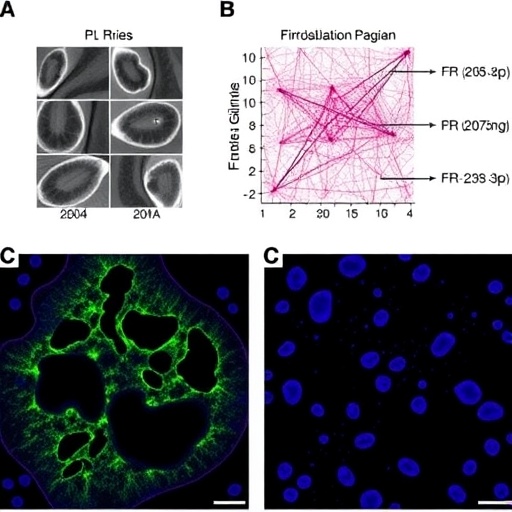In the relentless battle against colon cancer, groundbreaking research has illuminated a covert communication channel within the tumor microenvironment that escalates the malignancy and drug resistance of cancer cells. Scientists have discovered that exosomes — tiny extracellular vesicles — serve as molecular messengers, ferrying miR-223-3p, a microRNA, from carcinoma-associated fibroblasts (CAFs) directly to colon cancer cells. This exosomal transfer drastically alters cancer cell behavior by targeting the NF2/Hippo signaling pathway, a crucial regulator of cellular growth and tumor suppression. The findings open new avenues for therapeutic innovation, potentially transforming how colon cancer progression and chemoresistance are tackled.
Traditionally, colon cancer treatment has been hampered by the tumor microenvironment’s complex interactions, which often shield malignant cells from chemotherapy’s effects. The latest research surmounts this barrier by focusing on CAFs — a key stromal component notorious for nurturing tumor growth and resisting therapy — and their secreted exosomes. These exosomes encapsulate miR-223-3p, a small non-coding RNA molecule, designed to modulate gene expression. Once transferred into cancer cells, miR-223-3p reprograms intracellular signaling, particularly by downregulating components of the NF2/Hippo pathway, which normally suppresses tumor progression.
The NF2 gene encodes the protein Merlin, a known tumor suppressor, and its inactivation disrupts the Hippo pathway’s function, thereby unleashing unchecked cell proliferation and survival. By delivering miR-223-3p, CAF-derived exosomes effectively silence NF2, culminating in increased malignant potential and reduced sensitivity to chemotherapeutic agents. This mechanism elegantly demonstrates how cancer cells exploit their surrounding microenvironment to promote survival and evade treatment, leveraging intercellular communication at an unprecedented level of precision.
Employing a combination of molecular biology techniques, the researchers traced the origin and transmission dynamics of miR-223-3p, confirming its abundant presence in CAF-derived exosomes. Subsequent cellular assays revealed that colon cancer cells exposed to these exosomes exhibited enhanced invasive capacity, accelerated epithelial-to-mesenchymal transition (EMT), and resistance to common chemotherapeutics such as 5-fluorouracil and oxaliplatin. These phenotypic changes were largely reversed upon inhibiting the miR-223-3p function, underscoring its pivotal role in driving tumor aggressiveness.
Beyond cellular models, this investigation utilized patient-derived tumor samples to validate the clinical relevance of exosomal miR-223-3p. Elevated levels of this microRNA correlated strongly with advanced tumor grade, metastasis, and poor response to chemotherapy. This correlation positions miR-223-3p as both a potential biomarker for prognosis and a strategic therapeutic target. By intercepting or neutralizing these exosomal messages, treatments could sensitize tumors to conventional drugs, potentially enhancing survival rates.
At the molecular crossroads, the Hippo signaling pathway emerges as a central node influenced by miR-223-3p. Normally, Hippo signaling restricts organ size and suppresses tumors through controlling cell proliferation and apoptosis. Its suppression via NF2 downregulation lifts this brake, leading to uncontrolled growth and metastasis. This study elucidates the precise epigenetic sabotage executed by cancer-associated fibroblasts, providing a comprehensive map of how stromal cells can indirectly orchestrate malignancy through microRNA cargo.
The implications of this work extend beyond colon cancer, hinting at a broader paradigm in cancer biology where tumor-adjacent stromal cells play an active role in shaping treatment outcomes. Understanding exosomal communication opens a new frontier in cancer therapeutics, emphasizing the importance of disrupting not just the cancer cells but the supportive microenvironment that fuels malignancy. Targeted therapies that block exosome release, uptake, or miR-223-3p activity could radically alter therapeutic strategies.
Additionally, the study highlights challenges in drug development related to molecular delivery. Exosomes’ natural ability to traverse biological barriers and deliver functional RNAs positions them as both villains in cancer progression and potential allies in therapy design. Engineering artificial exosomes to deliver tumor-suppressing RNAs or inhibitors directly to tumors could revolutionize precision oncology, building upon the mechanistic insights provided by this research.
Furthermore, the findings challenge current clinical protocols by suggesting that addressing microenvironmental factors could be essential for overcoming chemoresistance. Combining traditional chemotherapy with agents targeting exosomal pathways or Hippo signaling components may offer synergistic effects, defeating tumors more effectively. This integrative approach addresses both intrinsic cancer cell mechanisms and extrinsic stromal influences, paving the way for comprehensive treatment regimens.
The revelations from this study contribute vitally to our understanding of microRNA-mediated cross-talk in the tumor niche. The specificity of miR-223-3p’s action and its mode of delivery via exosomes underscore a sophisticated biological strategy that cancer hijacks for survival. Such epigenetic modulation adds layers of complexity to cancer biology, demanding equally nuanced and multifaceted therapeutic approaches.
While the precise mechanisms regulating exosome production and loading of miR-223-3p remain to be fully elucidated, ongoing research is expected to uncover the triggers and controls governing this process. Deciphering these signals could offer additional targets to disrupt the malignant communication network. Insights gained here fuel optimism that next-generation therapies could intercept these molecular dialogues at inception.
In summary, the exosomal transfer of miR-223-3p from carcinoma-associated fibroblasts represents a crucial driver of colon cancer malignancy and chemoresistance, operating through the NF2/Hippo signaling pathway. This discovery highlights the significance of tumor-stromal interactions and identifies novel molecular targets for therapeutic intervention. As the oncology landscape evolves towards precision medicine, such foundational research will be instrumental in crafting smarter, more effective therapies against one of the most stubborn and deadly cancers.
By uncovering how tiny vesicles mediate big changes in tumor behavior, this study not only advances molecular oncology but also inspires innovative treatment paradigms that could one day diminish cancer’s devastating toll. Scientists and clinicians alike will watch keenly as future studies translate these molecular insights into real-world clinical victories against colon cancer.
Subject of Research: Exosomal transfer of microRNA miR-223-3p from carcinoma-associated fibroblasts and its impact on colon cancer malignancy and chemoresistance through NF2/Hippo signaling pathway.
Article Title: Exosomal transfer of miR-223-3p from carcinoma-associated fibroblasts promotes the malignant properties and chemoresistance of colon cancer cells by targeting NF2/Hippo signaling.
Article References:
Zhao, J., Zhang, J., Liu, J. et al. Exosomal transfer of miR-223-3p from carcinoma-associated fibroblasts promotes the malignant properties and chemoresistance of colon cancer cells by targeting NF2/Hippo signaling. Med Oncol 42, 503 (2025). https://doi.org/10.1007/s12032-025-03063-y
Image Credits: AI Generated




